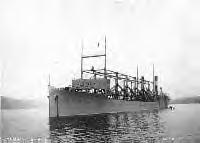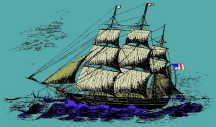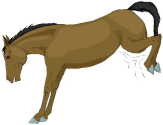
The largest ship to vanish without a trace in the history of the Navy was a collier known as the U.S.S. Cyclops. To this day, the ship has never been found!
![]()
 While cruising near the coastline off Punta Arenas, Chile, the British sailing ship Johnson sighted what appeared to be a boat with sails floating in the wind. When British signals elicited no response, the craft was approached. The crew noticed that the ship’s masts and sails were covered with some kind of green moss, and that the vessel seemed abandoned by its crew.
While cruising near the coastline off Punta Arenas, Chile, the British sailing ship Johnson sighted what appeared to be a boat with sails floating in the wind. When British signals elicited no response, the craft was approached. The crew noticed that the ship’s masts and sails were covered with some kind of green moss, and that the vessel seemed abandoned by its crew.
Upon boarding it, the skeleton of a man was discovered beneath the helm. The deck was decayed to such an extent, that it gave under the footsteps. Three more skeletons were found near a panel, ten were found in the crew’s quarters, and six on the bridge.
Upon the ravanged prow of the vessel, the words,Marlborough Glasgow, could still be discerned.
The Marlborugh left Littleton, N.Z. in January 1890 with a cargo of wool and frozen mutton, and a crew of 23 men under Captain Hird. In April 1890 an unsuccessful search for the vessel was made. Nothing was ever found of them until 1913.
Taken from the Wellington, New Zealand Evening Post
November 13, 1913 and Agence Havas
The “Dundee Star”, a scottish bark, abandoned by its crew in a gale off Midway Island, drifted completely around the world in 4 years and finally piled up in 1891 on Midway Island the very spot from which she started her phantom voyage.
![]()
 Click here to read a newspaper article about this huge fish which has made many people believe in “sea monsters”.
Click here to read a newspaper article about this huge fish which has made many people believe in “sea monsters”.
This very long, thin fish, with its strange looking head covered in protrusions and reaching lengths as long as 15 meters, could easily be taken for a sea monster.
The first account of this “sea monster” was probably in 1771 when Danish naturalist Morton Brunnich noted a beast he found washed up on the beach in Norway. The oarfish, is so named because of its long oar-like pelvic fins. A few examples of these fish have appeared over the years were usually found dead at the surface or washed up on a beach. Little is known about them.
![]()
The sailing ship, “Eclipse”, was struck by a meteor in the mid-pacific. The masts were carried away, and the vessel abandoned with the loss of 3 lives.
![]()
These are just some highlights of his interesting life…
– His real name was John Paul
– He was born in Scotland
– He was apprenticed on a ship at the age of 13. The ship sailed from Scotland to Virginia.
– He studied Navigation in VA.
– He served on 2 slave ships, as a mate.
– He sailed back to Scotland, but on the return trip both the Captain and Mate died, and he took command and sailed the ship back to Scotland.
– The owners of the ship gave him his own command at age 21
– He was terribly disliked by his men, and was said to be very demanding and harsh.
– He was brought to trial twice on murder charges. He got afraid for his life, during the second trial, and fled back to Virginia for safety, where he changed his name to John Jones.
– He could not find any work, so went to the Navy and was commissioned at a LT in the Continental Navy, where he took command of the Alfred. The Alfred was the first commissioned U.S. Naval Ship.
– Jones raised the first American flag to fly on a naval vessel.
– He refused several commands, because he felt them beneath him.
– In a raid he captured a British transport ship, loaded with clothing, and was promoted to Captain.
– He was named as 18th on the promotion list, and was so angry, that for the rest of his naval career he criticized the Navy.
– He commanded the Ranger, and captured the British ship Drake, after an hour’s fight off the shore of Ireland.
– He then got command of a rotton 40 gunship which he renamed the Bonhomme Richard, after Ben Franklin. With this same ship, he captured 17 other ships.
In 1779 off Flamborough Head, England, he engaged into a battle with the Seripas, and Countess of Scarborough. These were large 50 and 20 gun ships. Jones ship, the Bonhomme Richard, eventually sank, but the Seripas surrendered before it did.
– He then stayed in Paris and enjoyed his fame, and was given command of the 74 gun ship America.
– Jones then decided to go to Europe, and accept a Rear Admiral commission in the Russian Navy in 1783. But he had an argument with Prince Potemkin, and returned to Paris, where he died at age 43.
– Jones remains returned to the United States in 1905, and he is now buried in a crypt beneath the Naval Academy Chapel.
– In his lifetime, he had few friends, and was never married.
– His famous statement, “I have not yet begun to fight”, was said during his fight with the Seripas, when his own ship was sinking and in peril, and he was asked if he would surrender.
The rest is history!
![]()
 The art of designing ships in bottles was developed during the early 19th century when ocean voyages lasted for months and even years. Using whatever raw materials the crew members could scavenge, they developed their skills.
The art of designing ships in bottles was developed during the early 19th century when ocean voyages lasted for months and even years. Using whatever raw materials the crew members could scavenge, they developed their skills.
![]()
 From the time of the Vikings up to today, ships have used figureheads to ward off evil sea serpents and represent the spirit of the ship. This carved wood figure, placed on the bow of the ship, had no function other than to “see the way”. The term now denotes a person appointed to a leadership position, but has no real responsibilities.
From the time of the Vikings up to today, ships have used figureheads to ward off evil sea serpents and represent the spirit of the ship. This carved wood figure, placed on the bow of the ship, had no function other than to “see the way”. The term now denotes a person appointed to a leadership position, but has no real responsibilities.
![]()
 The five-masted bark “Kobenhaven” disappeared into the unknown. Although she carried radio equipment and auxiliary engines, 70 cadets, members of the most prominent family in Denmark, she vanished without a trace. Her fate is still unknown.
The five-masted bark “Kobenhaven” disappeared into the unknown. Although she carried radio equipment and auxiliary engines, 70 cadets, members of the most prominent family in Denmark, she vanished without a trace. Her fate is still unknown.
![]()
 Frank Tower survived the sinking of the Titanic, the Lusitania, and the Empress of Ireland.
Frank Tower survived the sinking of the Titanic, the Lusitania, and the Empress of Ireland.
![]()

He became a pirate because he could not sing! Frustrated in his ambition to be a crooner, he sought revengue on the high seas and became the greatest scoundrel of his time. He looted the ship “Mary Dier” of treasure worth $300,000,000, and buried it on Cocos Island near Panama in 1820. The treasure was never discovered.
![]()
The earliest official mention of keelhauling seems to be a Dutch ordinance of 1560 and the practice wasn’t formally abolished until 1853.
![]() Many of our Navy’s colorful expressions originated as practical means of communicating vital information. One such expression is “show a leg”.
Many of our Navy’s colorful expressions originated as practical means of communicating vital information. One such expression is “show a leg”.
In the British Navy of King George III and earlier, many sailors’ wives accompanied them on long voyages. This practice caused a multitude of problems, but some ingenious bosun solved one problem that tended to make reveille, (wake up time for civilians), a hazardous event: that of distinguishing which bunks held males and which held females.
To avoid dragging the wrong “mates” out of the rack, the bosun asked all to “show a leg”. If the leg shown was adorned with silk, the owner was allowed to continue sleeping. If the leg was hairy and tattooed, the owner was forced to “turn-to”.
In today’s Navy, showing a leg is a signal to the reveille petty officer that you have heard the call and are awake.
The term “knot”, or nautical mile, is used worldwide to denote a vessel’s speed through water. Today we measure knots with electronic devices, but 200 years ago such devices were unknown. Ingenious mariners devised a speed-measuring device both easy to use and reliable: the ‘log line’. From that device we get the term knot.
The log line was a length of twine marked at 47.33-foot intervals by colored knots. At one end was fastened a log chip; it was shaped like the sector of a circle and weighted at the rounded end with lead. When thrown over the stern, the log chip was floated pointing upward and and remains relatively stationary.
To measure the ship’s speed, a sailor would throw the log line over the stern and allow it to run free over the side for 28 seconds before hauling it aboard. He then counted the knots that had passed over the side to determine the ship’s speed.
![]()

Going back to the year 1734, a Norwegian missionary named Hans Egede took a voyage to Greenland. Here’s his undenied report…
” On the 6th of July 1734, there appeared a very terrible sea-animal which raised itself above the water. It’s head seemed to reach the maintop. It had a long sharp snout, it blew like a whale, had broad large flappers and the body was, as it were, covered with a hard skin, very wrinkled. Moreover, the lower part was snakelike. When it submerged it raised its tail above the water, a whole ship length from its body.”
Perhaps the most astounding case reported, came in Japanese waters back in 1977. A fishing trawler netted a huge heavy catch. When the fishermen brought it aboard, they saw the badly decomposed body of a strange unidentified gigantic sea creature. Its long neck dangled when they hung it up. This was no figment of their imagination. This decomposing sea creature’s body weighed in at 4000 pounds. Upon careful observation, it was definitely not a fish, nor a whale nor any other recognizable creature. The captain of the ZUIYO MARU took pictures. The captain said it measured 32 feet long! Flesh samples were taken along with full color pictures.
When he returned to shore, the captain developed the pictures and brought the findings to marine scientists. After they scoured over the information and photos of the remains, the scientists were truly baffled. This creature was totally unknown and could not be classified. However in piecing together the story and the clipped samples of dead flesh brought back , Japanese scientists concluded the creature was perhaps closest to the large land dinosaur the Plesiosaur, evolutionists claim became extinct some 70 million years ago.
![]()
Cochino (SS-345) 26 AUG 1949
The diesel-powered Cochino sank after a battery explosion during a severe storm off northern Norway. One crewman was killed and 7 more from the submarine Tusk (SS-426) attempting to rescue the Cochino’s despirate crew.
Stickleback (SS-415) 30 MAY 1958
During an exercise in Hawaiian waters the diesel-powered Stickleback lost power and broached the surface, where she was rammed by the destroyer escort Silverstein. All crew members were rescued before the sub sank the following day
Thresher (SSN-593) 10 APRIL 1963
The Thresher became America’s first nuclear-powered ship to be lost when she sank in 5,500 feet of water off the New England coast, taking with it 129 crewmembers.
A Court of Inquiry postulated the loss was in all probability due to a casting, piping, or welding failure that flooded the engine room with water. The water probably caused electrical failures that automatically shut down the nuclear reactor, and caused initial power loss.
The sub apparently went into an uncontrolled dive that ended when she reached her crush depth.
Scorpion (SSN-589) 27 MAY 1968
The nuclear-powered Scorpion sank in over 10,000 feet of water about 400 miles southwest of the Azores; 99 crew were killed.
The cause of the loss has not been conclusively found, although the official Navy history indicates that most probably, “inadvertent activation of battery of torpedo resulting in a possible ‘hot run’ torpedo”
![]()
The origin of the word “scuttlebutt”, which is nautical parlance for a rumor, comes from a combination of “scuttle”, to make a hole in the ship’s side causing her to sink, and “butt”, a cask or hogshead used in the days of wooden ships to hold drinking water; thus the term “scuttlebutt” means a cask with a hole in it. “Scuttle” describes what most rumors accomplish if not to the ship, at least to morale. “Butt” describes the water cask where men naturally congregated, and that’s where most rumors get started. The terms “galley yarn” and “messdeck intelligence” also mean the spreading of rumors and many, of course, start on the messdeck.
![]()
 The words of Samuel Taylor Coleridge “Idle as a painted ship upon a painted ocean” well describe a sailing ship’s situation when it entered the horse latitudes. Located near the West Indies between 30 and 40 degrees north latitude, these waters were noted for unfavorable winds that becalmed cattle ships headed from Europe to America.
The words of Samuel Taylor Coleridge “Idle as a painted ship upon a painted ocean” well describe a sailing ship’s situation when it entered the horse latitudes. Located near the West Indies between 30 and 40 degrees north latitude, these waters were noted for unfavorable winds that becalmed cattle ships headed from Europe to America.
Often ships carrying horses would have to cast several overboard to conserve drinking water for the rest of the ship rode out the unfavorable winds. Because so many horses and other cattle were tossed to sea, the area became known as the “horse latitudes”.
 Dog watch is the name given to the 1600-1800 and 1800-2000 watches aboard ship. The 1600-2000 4-hour watch was originally split to prevent men from always having to stand the same watches daily. As a result, sailors dodge the same daily routine, hence they are dodging the watch or standing the dodge watch.
Dog watch is the name given to the 1600-1800 and 1800-2000 watches aboard ship. The 1600-2000 4-hour watch was originally split to prevent men from always having to stand the same watches daily. As a result, sailors dodge the same daily routine, hence they are dodging the watch or standing the dodge watch.
In the days of sailing, this modern term for deception meant disquising your ship’s nationality by flying colors that were not your own. This practice was common among pirates. Today an intentional deception among friends, meant as a joke, is said to be ‘bamboozling’.
![]()
This is a modern gambling term that has nautical origins. Because the guns on early ships were inaccurate except when fired at close range, it was an extremely lucky long-shot that would find its target at a great distance.
![]()
“Slush”, a watery mix of fats made from scraping the empty meat storage barrels, was often sold ashore by the ship’s cook, who would pocket the profit. The money became known as a “slush fund”.
![]()
This is the term for being finished with one task and ready for a new one. It came from a square-rigged ship with her yards braced so the ship was said to run ‘squarely’ ahead of the wind.
![]()
If the “sheets” which are the rope lines used to control the sails, are loose on a fully rigged ship, the sails flap and flutter in the air and are said to be “in the wind”. A ship in this condition appears ‘drunk’ because it shudders and staggers in the water, aimlessly floating about.
![]()
The bow of a ship that comes under the constant beating of the sea or “under the weather”, is where sailors below deck were most likely to become seasick. The phrase evolved to indicate feeling ill.
![]()
Admiral Wallop of King Henry VIII’s navy gained notoriety after he and his ships were sent to the French coast to retaliate for the burning of the town of Brighton, England. He so thoroughly destroyed his enemies that his name now indicates a ‘mighty blow’.
![]()
 Today the expression “devil to pay” is used primarily as a means of conveying an unpleasant and impending happening. Originally, this expression denoted the specific task aboard ship of caulking the ship’s longest seam.
Today the expression “devil to pay” is used primarily as a means of conveying an unpleasant and impending happening. Originally, this expression denoted the specific task aboard ship of caulking the ship’s longest seam.
The “devil” was the longest seam on the wooden ship, and caulking was done with “pay” or pitch. This grueling task of paying the devil was despised by every seaman, and the expression came to denote any unpleasant task.
![]()
Umbrellas and cards: Umbrellas and playing cards were usually thought of as taboo at sea. Cards have always been connected with fortune telling and were thought of as the Devil’s picture books. Some say that tearing up a deck, and tossing it overboard, will produce a favorable change in the wind.
Pig Problems: In the West Indies, “pig” was traditionally a taboo word. The animal was known instead as “Curly Tail, Mr. Dennis, Gruff, Little Fellah, the Grecian, or Turf Rooter”.
The pig was treated with great respect because it had cloven hooves like the devil, and was the totem beast of Mother Earth, who controlled the 4 winds.
Sailors believed that even the mention of the name would produce strong winds and storms.
Left and Right Boots: On the east coast of Scotland there is an ancient superstition that among fishermen the left boot is unlucky. But the right boot is traditionally believed to be lucky. If found the right boot is nailed to the mast to bring the boat good fishing and fortune.
Sacrifices: Long ago the least-valued member of the crew was sometimes sacrificed in the event of bad weather. This crewmember was often the poor cook. On the opposite end of this line of thinking, it was believed that a storm could be calmed by a woman exposing her breasts. This is why ship’s figureheads are often of naked women.
Tatoos: In 1771, HMS Endeavour, under the command of Lt. James Cook, visited the island of Tahiti, and a seaman named Robert Stainsby had himself tatooed by a native. The craze for tatoos soon caught on as sailors thought a tatoo could increase their luck. A crucifix was a popular tatoo, as it was supposed to increase the chances of a Christian burial if the sailor were somehow lost at sea and later found washed up on shore.
Also, a rooster and pig, each tatooed on one knee was popular. It ensured the seaman that he never went hungry as he would carry with him his own “bacon and eggs”.
Sailors often got swallow tattoos on their chest. The most common explaination is that you got a swallow tatoo for crossing the Atlantic, and one for travelling over 5,000 nautical miles. Why swallows? Because they always find their way home.
In the 18th century it was common punishment for a sailor to be given 24 or more lashes for being drunk on duty. So sailors began to get a crucifix tatooed on their backs. Now only would the bosun’s mate flinch from laying his whip on Christ, but it was believed that the lash itself would cringe away.
Perils of the Sea: Sailors have adopted beliefs from anywhere and in anything that seems to work. Animals, birds, names, even whistling, can all be dire omens at sea.
These beliefs are taken so seriously that the British Admiralty still takes enormous care in naming ships in the fleet. Reptile names are almost completely banned nowadays. The Navy, in the past, lost 4 Vipers, 4 Serpents, a Cobra, an Adder, an Alligator, and a Crocodile. They also lost 2 Snakes, 2 Dragons, and Lizards.
Religious Reference: The salute to the quarterdeck that the sailor makes when coming aboard has it’s origin in the time when a crucifix hung there.
Some fishermen will stay ashore for the day if they meet a priest or nun on the way to the harbor. In the Faeroe Isnalds, between Norway and Iceland, whale hunters believe that their prey will get away if a boat with a minister aboard sails between them and the shore.
Even reading aloud or quoting phrases from the Bible at sea carries a terrible risk, except during a burial. In 1701,on the flagship, Association, of Admiral Sir Cloudesley Shovell, a condemned sailor shouted the words of the 109th Psalm, “May his days be few; may another seize his goods. May his children be fatherless, and his wife a widow. Let there be none to extend kindness to him.” Later the same year the Association and 2 other ships sank off the Scilly Isles with the loss of 200 men. According to legend, Sir Cloudesley, the man who had passed sentence on the sailor, was washed ashore unconscious, and buried alive. On her deathbed, the woman who later confessed that she murdered the admiral, found him on the beach and hacked off his fingers to obtain the rings he wore.
Reincarnation: In the days of sail, dead mariners were believed to be reincarnated in the bodies of petrels and seaglls. If one of these birds appeared over a ship in midocean, it was a sign of storms to come.
The huge albatross of the southern seas held the most awe. To see one meant that a storm was a certainty. To kill one brought an eternity of bad luck. This is referenced in the poem “The Rime of the Ancient Mariner”, by Coleridge.
In 1959 a cargo ship named Calpean Star had to carry an albatross on its way from the Antarctic to a zoo in Germany. When the ship docked at Liverpool with engine trouble, the crew walked off, claiming that the albatross was responsible for the misfortunes on the voyage. Only after the albatross died in its cage a day later was the Captain able to find another crew to take the ship out of port.
Whistling: Perhaps the most curious of all beliefs at sea is that whistling is often banned. The logs of modern liners show that even in the past 100 years seamen were disciplined for breaking the taboo. Whistling was thought to encourage high winds and was allowed only when the ship was becalmed or shrouded in mist.
Throwing A Coin Overboard: A way of getting rid of mist or to buy a calm sea was to throw a coin overboard. When a storm blew up near the Bishop Rock lighthouse off the Scilly Isles, the keepers blame someone who then has to hurl a coin into the sea.
Sir Francis Drake’s Drum: It has long been believed that a drum owned by Sir Francis Drake possesses strange powers. When he was dying off the coast of Panama in 1596, Drake ordered his drum to be sent back to his home near Plymouth, England, where it hangs to this day.
Drake had vowed on his deathbed that if anyone beat upon it when England was in danger, that he would return to defend his country. But the legend changed through the years. Now the drum rolls out ghostly warnings on its own. It is said that the drum gave a growl when Napoleon was brought as a prisoner to Plymouth following the Battle of Waterloo. And it has been heard 3 times in this century: once in 1914 when the first World War started; 4 years later aboard the flagship Royal Oak and once in the second World War during the retreat from Dunkirk.
In 1918 as the German fleet steamed into Scapa Flow to surrender, a drum began an echoing tattoo somewhere within the Royal Oak. The commander himself made an unsuccessful search of the ship. But no sign of the drummer was found.
When the Royal Oak dropped anchor, the drums victory roll stopped, as mysteriously as it began. Drake was at rest once again.
CLICK HERE to learn about Naval terms and expressions.
